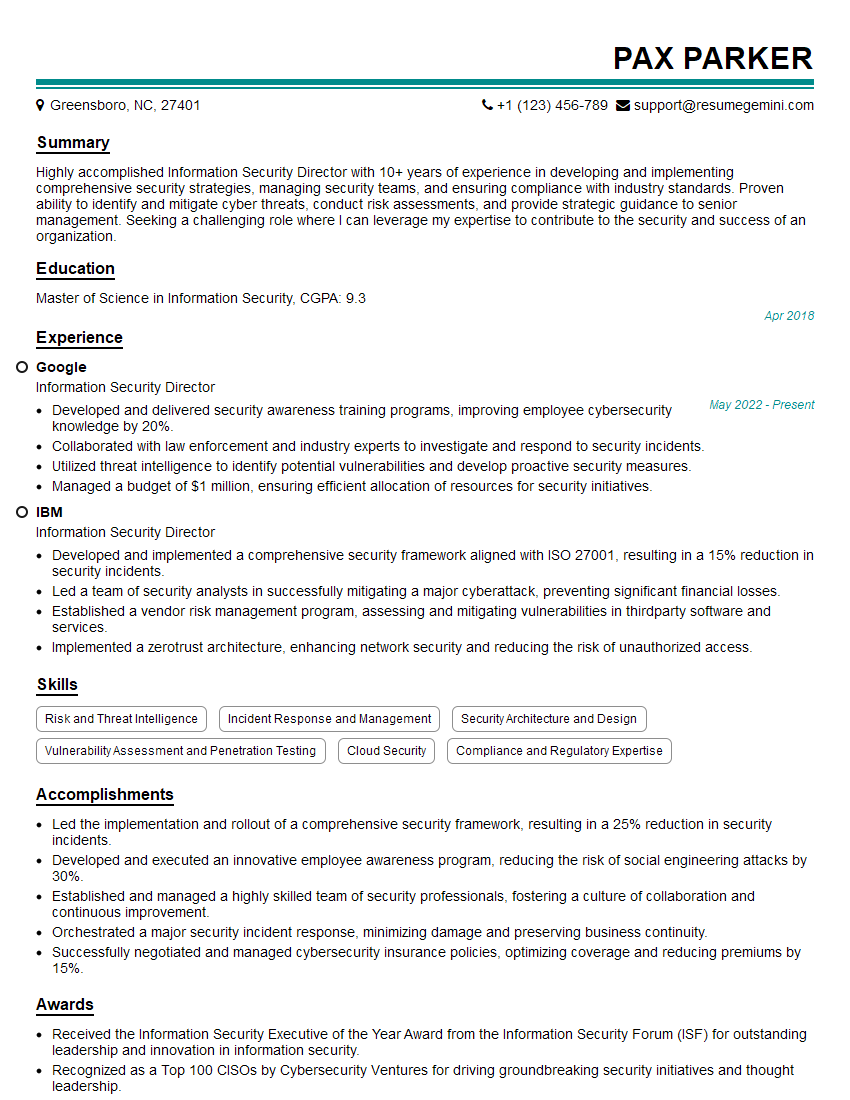Are you a seasoned Information Security Director seeking a new career path? Discover our professionally built Information Security Director Resume Template. This time-saving tool provides a solid foundation for your job search. Simply click “Edit Resume” to customize it with your unique experiences and achievements. Customize fonts and colors to match your personal style and increase your chances of landing your dream job. Explore more Resume Templates for additional options.

Pax Parker
Information Security Director
Summary
Highly accomplished Information Security Director with 10+ years of experience in developing and implementing comprehensive security strategies, managing security teams, and ensuring compliance with industry standards. Proven ability to identify and mitigate cyber threats, conduct risk assessments, and provide strategic guidance to senior management. Seeking a challenging role where I can leverage my expertise to contribute to the security and success of an organization.
Education
Master of Science in Information Security
April 2018
Skills
- Risk and Threat Intelligence
- Incident Response and Management
- Security Architecture and Design
- Vulnerability Assessment and Penetration Testing
- Cloud Security
- Compliance and Regulatory Expertise
Work Experience
Information Security Director
- Developed and delivered security awareness training programs, improving employee cybersecurity knowledge by 20%.
- Collaborated with law enforcement and industry experts to investigate and respond to security incidents.
- Utilized threat intelligence to identify potential vulnerabilities and develop proactive security measures.
- Managed a budget of $1 million, ensuring efficient allocation of resources for security initiatives.
Information Security Director
- Developed and implemented a comprehensive security framework aligned with ISO 27001, resulting in a 15% reduction in security incidents.
- Led a team of security analysts in successfully mitigating a major cyberattack, preventing significant financial losses.
- Established a vendor risk management program, assessing and mitigating vulnerabilities in thirdparty software and services.
- Implemented a zerotrust architecture, enhancing network security and reducing the risk of unauthorized access.
Accomplishments
- Led the implementation and rollout of a comprehensive security framework, resulting in a 25% reduction in security incidents.
- Developed and executed an innovative employee awareness program, reducing the risk of social engineering attacks by 30%.
- Established and managed a highly skilled team of security professionals, fostering a culture of collaboration and continuous improvement.
- Orchestrated a major security incident response, minimizing damage and preserving business continuity.
- Successfully negotiated and managed cybersecurity insurance policies, optimizing coverage and reducing premiums by 15%.
Awards
- Received the Information Security Executive of the Year Award from the Information Security Forum (ISF) for outstanding leadership and innovation in information security.
- Recognized as a Top 100 CISOs by Cybersecurity Ventures for driving groundbreaking security initiatives and thought leadership.
- Awarded the Cybersecurity Leadership Award by the National Cyber Security Alliance for exceptional contributions to promoting cybersecurity awareness and best practices.
- Conferred the CSO50 Award by CSO Magazine for exceptional leadership and vision in driving organizational cybersecurity.
Certificates
- CISSP (Certified Information Systems Security Professional)
- CISM (Certified Information Security Manager)
- CISA (Certified Information Systems Auditor)
- CEH (Certified Ethical Hacker)
Career Expert Tips:
- Select the ideal resume template to showcase your professional experience effectively.
- Master the art of resume writing to highlight your unique qualifications and achievements.
- Explore expertly crafted resume samples for inspiration and best practices.
- Build your best resume for free this new year with ResumeGemini. Enjoy exclusive discounts on ATS optimized resume templates.
How To Write Resume For Information Security Director
- Highlight your experience in developing and implementing security frameworks and policies.
- Showcase your skills in managing security teams and conducting risk assessments.
- Quantify your accomplishments using specific metrics and results.
- Demonstrate your ability to communicate effectively with technical and non-technical audiences.
- Emphasize your understanding of industry best practices and regulatory requirements.
Essential Experience Highlights for a Strong Information Security Director Resume
- Develop and implement comprehensive security programs aligned with industry best practices and regulatory requirements
- Lead and manage a team of security analysts and engineers
- Conduct risk assessments and vulnerability assessments to identify and mitigate threats
- Investigate and respond to security incidents, including data breaches and cyberattacks
- Develop and deliver security awareness training programs to educate employees on cybersecurity best practices
- Collaborate with business units to integrate security into business processes
- Stay up-to-date on the latest security trends and technologies
Frequently Asked Questions (FAQ’s) For Information Security Director
What are the key responsibilities of an Information Security Director?
The key responsibilities of an Information Security Director include developing and implementing security strategies, managing security teams, conducting risk assessments, investigating and responding to security incidents, and providing strategic guidance to senior management.
What are the qualifications required to become an Information Security Director?
To become an Information Security Director, you typically need a bachelor’s or master’s degree in computer science, information security, or a related field, as well as several years of experience in information security management.
What are the career prospects for Information Security Directors?
Information Security Directors are in high demand due to the increasing threat of cyberattacks. Job growth is expected to be strong in the coming years as organizations continue to invest in their security.
What are some of the challenges that Information Security Directors face?
Information Security Directors face a number of challenges, including the increasing sophistication of cyberattacks, the growing volume of data that needs to be protected, and the need to comply with a complex and evolving regulatory landscape.
What are some of the key trends in information security?
Some of the key trends in information security include the adoption of cloud computing, the increasing use of mobile devices, and the growing threat of ransomware.
What are the top skills that Information Security Directors need?
The top skills that Information Security Directors need include risk assessment, incident response, security architecture, and compliance.